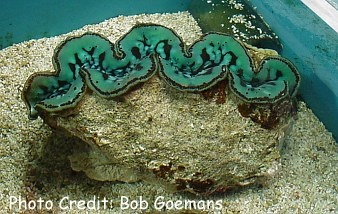
By Bob Goemans

Likely Reef Tank Suitable
Likely Fish-Only Tank Suitable
Range: Indo-Pacific Ocean to Micronesia.
Size: 6 inches (15 cm)
Natural Environment: Inhabits upper reef areas of intertidal zones between depths of about 3 to 20 feet (1 - 6 m) where it burrows hinge first into or among rocks and corals.
General Husbandry: Has a more smooth outer shell than T. maxima. Also has intense combinations of fluorescent purple, blue, and green colors in its mantle.
They are also filter feeders and almost constantly filter the water for small particulates. Small specimens, < 2 - 3 inches can be fed a phytoplankton or greenwater supplement at least three times per week, which may encourage their growth. Larger specimens will do extremely well without any additional feedings.
So as not to repeat some of the Introduction to this section, review it for more information on their aquarium husbandry.
Taxonomy:
Kingdom: Animalia
Phylum: Mollusca
Class: Bivalvia
Subclass: Heterodonta
Order: Cardiida
Superfamily: Cardioidea
Family: Cardiidae
Subfamily: Tridacinae
Genus: Tridacna
FYI: Mariculture stock available.
In the wild, can bore deep into limestone rock where only the inlet and outlet siphons are visible.
Experience Level: Intermediate
Diet: Photosynthetic/Omnivore
Temperament: Peaceful
Aquarium Environment: Reef or fish-only aquarium
Coral Safe: Yes
Fish Safe: Yes
Invertebrate Safe: Yes
Acclimation Time: 30 minutes+
Aquarium Hardiness: Moderately hardy
Calcium (Ca): 380 - 430 mg/l
Alkalinity: 2.5 - 3.0 meq/l
Phosphate (PO4): <0.05 mg/l
Magnesium (Mg): approx. 1350 mg/l (relate to specific gravity)
Temperature Range: 72 - 83°F (22 - 28°C)
Minimum Tank Size: 50 gallons
Lighting: PAR 450+
Water Movement: WM 2
Specific Gravity: 1.023 - 1.025
pH: 8.0 - 8.4
Iodine/Trace Elements Monitor/as necessary to maintain quality seawater.
